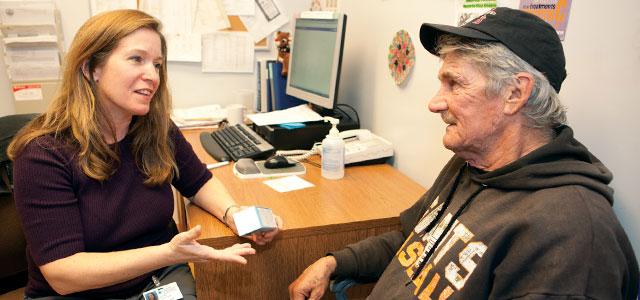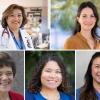
Kim Pelish, NP, with a patient at the San Francisco Housing and Urban Health clinic (photo by Elisabeth Fall)
What Volunteer Clinical Faculty Do: Alumna Kim Pelish Helps People with Multiple and Complex Health Care Needs
Volunteer clinical faculty and preceptors offer students individual perspectives and hands-on experience in a variety of health care settings and specialties. The cumulative effect of what these volunteers impart plays a significant role in the care any health system delivers. This series aims to shed light on the unique roles these valuable mentors play.
This month we hear from Kim Pelish, Direct Access to Housing (DAH) access and referral team coordinator, San Francisco Department of Public Health.
When I moved to San Francisco in 1992, I was in my early 20s and thought I might want to pursue a career in social work, so I started working in homeless shelters. It was around that time I saw a team called Health Care for the Homeless come in to see our homeless patients, and I remember thinking, “This is what I want to do.” I saw the nurse practitioner role as a deep marriage between practical, hands-on work and something that seemed very intellectually juicy.
I knew as well that my heart was in working with a multiple needs population. When I got into the UCSF MEPN program, I was able to create an integrated program that would prepare me for future work. I did studies in adult psychology and primary care, the whole while working with patients with multiple diagnoses. The community-based settings that I worked in were meant to construct a supportive place for folks with psychiatric issues who needed a stable home on an interim basis.
It was after I graduated in 2001 and began working in places like the Haight Ashbury Free Clinics that I saw an ad for my dream job – working in the Emergency Department Case Management Program at San Francisco General Hospital. I’d be working with low-income and homeless people, many of them with multiple medical needs. Our mandate was to provide the type of wraparound services needed to really treat patients on a deeper plane. We used a team approach consisting of case managers, nurse practitioner (myself), physician, psychiatrist and, once I developed the program, nurse practitioner and pharmacy students. We knew that no diagnosis existed in a vacuum – therapy linked to substance abuse, which linked to medication adherence, which linked to psychiatric care. It was the type of complex, holistic environment I wanted to be in. We would sometimes follow patients for up to 10 years because that’s how long it took to engage them. I stayed there for 10 years, through July 2012, and that’s where I had all of my students.
For those students, it was incredible training, because the type of patients we had were so complex. Treatment was not just a matter of ordering tests; patients needed to be calmed down and made comfortable. There were so many variables. Students learned to work as part of a team to address the whole patient.
Early on, I decided I wanted to approach teaching in a similar way to one of my most trusted mentors. I wanted to be fully present for the students. This meant if someone asked a question, I wanted to validate it – I wanted to listen to them and acknowledge that we were not dealing with black-and-white situations. I wanted to give students independence while still being there to take responsibility for their work – it’s a lesson I learned from my own mentors.
At the end of the day, students often learn that our patients are our teachers, and our life in this work can teach us so much. I took students to see where our patients lived and the conditions they battled – I wanted them to see the context of our work. People have to deal with so much, in addition to taking care of themselves.
The students – their enthusiasm – would re-energize me, and I enjoyed being able to provide them with an incredible learning environment that would make them better health care providers.
Today I am working both as a coordinator in the San Francisco Department of Public Health’s Direct Access to Housing program and as a primary care clinician at the Housing and Urban Health clinic. At the latter, I still work with a similar population; most are urban and low-income. The city program that runs our clinic also provides about 1,500 housing units for people in grave need of a supportive place to live. As in my previous work, these living communities are about constructing a holistic space for people to become well. I sort through various cases and match people in need with available units. These are people who might have previously been institutionalized, and instead they are given a shot at independent living.
Right now I have about 1,000 people in our waiting pool, and we get at least 30 referrals a week. There is a great need for this type of program. In many ways the decisions I make in my job are incredibly difficult, but I also see every day the extraordinary need that is out there and the ways I am uniquely positioned to help. In this line of work, you have to look at the silver lining.



